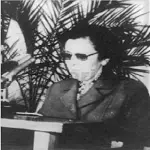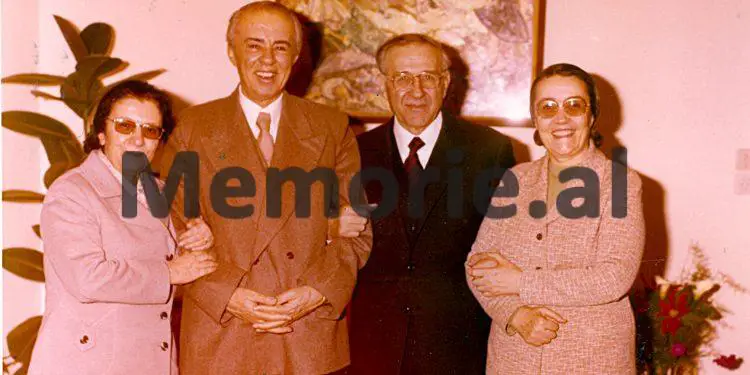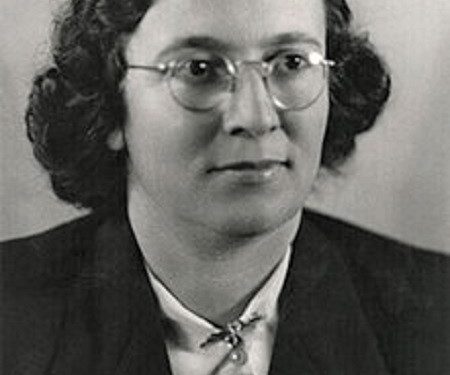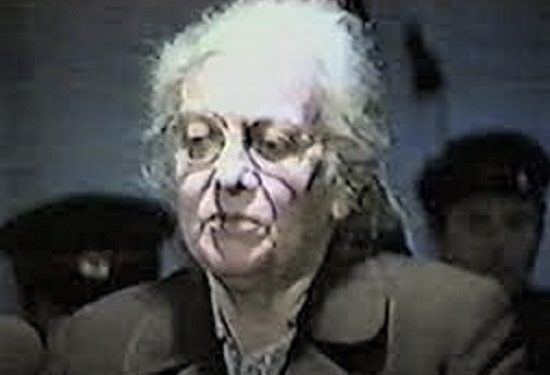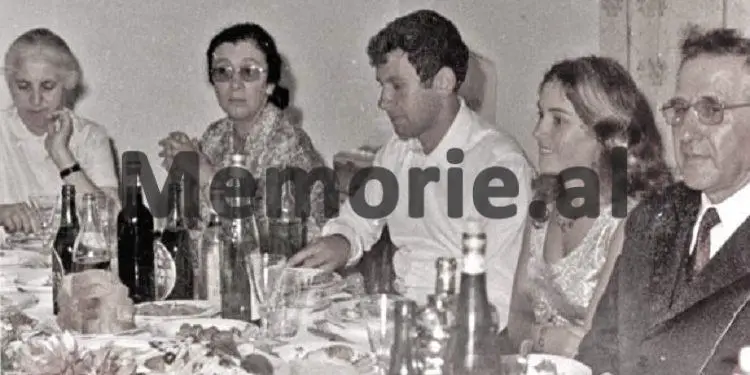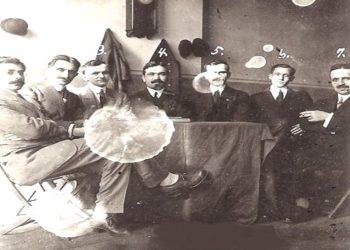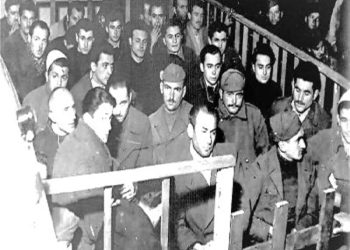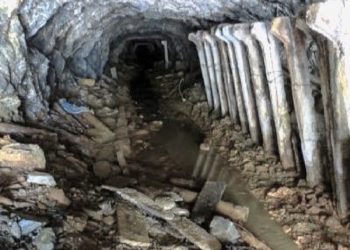By Afrim Imaj
The fifth part
Memorie.al / At the end of August and the beginning of September of 1983, a mysterious video that was distributed a few days before the trial of Fiqirete Shehu, prepared with her testimony during the investigative process by the people of the State Security, was distributed in all the cities of Albania from the South to the North which was heard with the center of the voice in the most important institutions, enterprises and work centers of production throughout the country. The widow of the former prime minister who committed suicide under suspicious circumstances, affirmed with her own mouth, the whole mystery of the sensational event as well as her “hostile activity” and that of the Shehu family as well. All those who had the opportunity to know him closely, were surprised by the testimony of Fiqirete Shehu, Mehmet Shehu’s wife, (former member of the Central Committee of the Party since April 1952, former director of the High School of the Party ” Vladmir Ilic Lenin” in Tirana), while the majority of the people, workers and peasants wherever they were, believed blindly, everything was said in that ghostly video, where she confessed with conviction, plots after plots, devised by her husband and others, with the sole purpose of carrying out the assassination of the main leader of the Party, Enver Hoxha!
After her testimony, the senior leadership of PPSh headed by Enver Hoxha, Ramiz Ali and the Minister of Internal Affairs, Hekuran Isain, who were the main creators of that process and the video that was served to the Albanians with the testimony of Fiqrtet Shehu, thought that all doubts about the suicide of former Prime Minister Mehmet Shehu would be closed. But soon, people would start talking under their breath and questioning her statements, thinking that she was repeating what the investigators and the Security people dictated to her. Meanwhile, the first hypotheses arose, according to which Fiqiretja was forced to do everything in order to save the rest of the family, the children.
Continues from last issue
Temptation for children’s lives
“Everyone is an enemy. All of them were shot!” He shot the woman who was a resident of the same cell as Fiqirete Shehu, to listen to her confession, late one evening while returning from the trial of Kadri Hazbiu.
She remembers the alienation that had made Mehmet’s widow disfigured and remembers her reactions when she asked him what had happened. “I said that they are all enemies, from my husband to the simple guard who presented me in the process. That’s how they should be. That’s how they wanted them to be. That’s how I denounced them. What else should I do? Maybe they keep their word and don’t do anything to the children…”!
Anyway, concludes the woman from the north who had spent days with Fiqrete Shehu, they destroyed her and her children, one of them was killed in Gramsh, the other two were imprisoned in Burrel prison.
Shehu family drama
After finishing the “suicide” version, Enver Hoxha continued his brutal fight against the family of Mehmet Shehu. In June 1982, in Gramsh (deported here) the eldest son of Mehmet Shehu, Vladimiri, according to the official version, killed himself. While Mehmet’s wife and their sons, Skenderi and Bashkimi, after a short exile, were arrested at the beginning of 1982, “tried” and imprisoned. Mehmet’s sons were imprisoned in Burrel while Fiqireti in prison 313 in Tirana.
Testimony of a co-sufferer of Fiqret Shehu, Vjollca Leka from Elbasan, who has been in the same cell for more than three years, in Zeimeni Prison, Lezhë, with Mehmet Shehu’s wife, Fiqrete.
Who is Vjollca Leka, the former cellmate of Fiqret Shehu?
“I was born in Elbasan on June 3, 1948. I graduated from high school for Economics and for many years I worked in the Elbasan Commercial Enterprise. In 1984, the then regime sentenced me to 25 years in prison, on the charge of “damaging the socialist economy”.
Where did you serve your sentence?
In the Kosovo prison in Elbasan, then I was transferred to Zeimeni Prison, Lezhe
When did you meet Fiqret Shehu for the first time?
In the prison of Tirana. It was January 1986. I and another convict were taken to a cell with Fiqrete Shehu. Earlier, two other women had been there. This was also my first acquaintance with him.
Who was the other convict in a cell with you?
Sose Demiri, from Tropoja.
How was Fiqret Shehu’s health?
Physically, Fiqreti was weak. Something changed when we started cooking inside the cell.
Did Fiqreti talk to you about the worries he had?
Fiqreti spoke very little.
Has she told you about any of her family’s assets?
No.
Did she have doubts about the “suicide” of Mehmet Shehu?
Fiqreti wasn’t completely sure of suicide, but she didn’t talk anymore.
Was torture often used on Fiqret Shehu?
I remember that the investigator of her case, whose name I do not remember, often addressed her with the words: “I will make a map on the wall, I will make a mess”.
In those cases that Fiqreti spoke, did he silence any senior communist leader, for better or for worse?
Generally she talked about their wives. He remembered that Nexhmije Hoxha had been a close friend. He was surprisingly saddened by the death of Ramiz’s wife Ali, in the spring of 1986.
Another time, she told us that the names of her two sons were named by Enver Hoxha himself.
Had a meeting with her sons, Fiqreti in prison?
Yes and this meeting were around June 1988, that is, a few weeks before he died. This meeting took place in the premises of the Tirana prison.
What were the circumstances of Fiqret’s death?
In the first two weeks of September 1988, her health deteriorated rapidly. Jaundice was suspected, but it was soon seen that it was not. At 21:00 on September 11, 1988, which I remember very well, as it was the day of the innovators, she became very ill and died a few minutes later.
What do you keep as a memory of her?
The handkerchief, which is what I have in my hand.
How Enver Hoxha personally took care of the investigation, filming and photographing Fiqirete Shehu under torture
Enver Hoxha, from December 18, 1981 until November 18, 1982, around 10 hours a day, locked himself in his office and carefully checked the photographs of the dead bodies of Mehmet Shehu, Fiqrete Shehu, Kadri Hazbiu, Fiçor Shehu , Llambi Ziçishti and Llambi Peçin. But Enver Hoxha has searched and carefully checked the photographs of Mehmet Shehu’s son, Vladimir Shehu, who died under very mysterious circumstances in exile in Gramsh.
All the reports of Enver Hoxha, with the files of the “hostile group” of 21 people, headed by Fiqrete Shehu and Kadri Hazbiu, are located in the Archive of the Ministry of the Interior. The former officer, who served for almost 20 years with the former commander, in his book, brings all the details of Enver Hoxha’s reports with the 21 files of the “hostile group” accused of being agents of the American CIA.
January 18, 1982
The commander went to the office early in the morning. He was very nervous and his hands were shaking. Entering the office, he ordered that no one disturb him as he has a very important phone call. The day before, Hekuran Isai had been in his office and the two of them together, face to face, had discussed for a long time with each other. At 14.00, in the village of Belsh in Elbasan, Fiqrete Shehu and her son, Skënder Shehu, were arrested. The accusation was formulated with only three words: “Enemies of the Party”. Everyone confirmed that the charge was formulated by the Commander himself and it was a very strong charge. The purpose of the arrest, written in the instruction letter signed by Enver Hoxha, was: “To prove that Mehmet Shehu was an agent of the American CIA”.
In the list of 17 tasks, which Enver Hoxha had done and which is located in Box 801, in the Archives of the Ministry of the Interior, it is said that; it must be revealed that Fiqrete Shehu has carried out duties assigned by Mehmet Shehu, when she allegedly went to meet her son, Skenderi, in Denmark and Sweden. The two arrested, even though they were tortured and massacred by the group of investigators for almost 30 days, did not accept any of the charges.
The commander (Enver Hoxha) personally dealt with their investigation. He is interested and has been very stressed about the investigation against Fiqrete Shehu. A very large amount of photographs were taken during the arrest of Fiqrete Shehu, while the investigation against her was filmed for around four hours. On February 17, 1982, Enver Hoxha was locked in his office for five hours, looking closely at all the details of Fiqirete Shehu’s investigation.
February 18, 1982
The commander got up early again and was very distracted. It was one of the first times he had uncombed hair. But everyone thought that the Commander was sick with diabetes and that was the reason why he had uncombed hair. But at 12.00, the news broke that Fiçor Shehu, former Minister of the Interior, has been arrested. His arrest made a big fuss. But more shocking was the news that Mehmet Shehu’s son, Vladimir Shehu, who was interned in Gramsh, had died under mysterious circumstances. The commander asked to know all the details of the death of Mehmet Shehu’s son, Vladimir Shehu.
To him in the office, they brought the complete file of the death certificate of Mehmet Shehu’s son. On each sheet of the file, two photographs of Mehmet Shehu’s dead son were pasted. He stayed for more than 12 hours in the office, closed on this file, waiting for the news, how the arrest of Feçor Shehu went. But the most tragic part noted in the record of questions, for almost 30 days of Feçor Shehu, (first cousin of Mehmet Shehu), is that he did not accept any of the charges. The torture at his address lasted for 8 consecutive months, until the end of September 1982. He was able to survive with very serious wounds on his body, until October 18, 1982, when Enver Hoxha’s order arrived to shoot him. .
Indisputably, it can be said that; Feçor Shehu was the only victim of the communist dictatorship who did not accept the accusation, did not agree to speak and was not broken by inhuman torture. He lived for almost three months, tied hand and foot and with a spacesuit on his head. Feçor Shehu’s file, complete and with many details, is located in the secret archive of the Ministry of the Interior. In this file, there are details of all the witnesses who appeared in his investigation behind closed doors, in Prison 313 in Tirana.
Over 30 photographs of the dead Feçor Shehu are in File No. 912, in this archive. These photographs and another part have been in Enver Hoxha’s office for almost 10 days. For Feçor Shehu and the other 21 members of his “enemy group”, there are also four film cassettes. These film cassettes have passed through Enver Hoxha’s filter several times. He personally took care of what to expect from the recordings of the investigation and the closed-door trial of Feçor Shehu and the other 21 detainees.
March 18, 1982
On March 18, 1982, 18 other members of Mehmet Shehu’s “hostile group” were arrested. At the top of the list were: Kadri Hazbiu and Llambi Zicishti, at that time former Minister of Health. Enver Hoxha, on film tapes, was brought to his office the entire procedure of the arrest of the hostile group. Enver Hoxha, since December 18, 1981, until the end of November 1982, dealt almost every day with the files of the “hostile group” of 21 high officials, led by Kadri Hazbiu and Fiqirete Shehu. The accusation against Kadri Hazbi was the same as that of Mehmet Shehu, Fiqirete Shehu and Kadri Hazbi.
Of the 21 arrested of the hostile group, Llambi Peçini, Llambi Ziçishti, Feçor Shehu and Kadri Hazbiu, were sentenced to be shot. But none of them broke in Enver Hoxha’s investigation. Only at the end of February 1982, when Fiqrete Shehu learned of the death of her son, in order to save the other two sons, she pretended to accept the accusation. Film tapes were immediately made, with Fiqirete Shehu’s questions.
In these tapes, there are many montages. In Enver Hoxha’s office, the material went assembled, while the most painful parts were removed. In these tapes, Fiqrete Shehu was filmed in cell 101, on the first floor, of Prison 313. During eight hours of question-and-answer, Fiqrete Shehu explained, always according to the filmed tapes, that she is an agent. But the most painful part and that changed the whole course of events, was the death of Fiqrete Shehu in prison, quite suddenly. Hundreds of photographs were taken of Fiqrete Shehu’s corpse in the prison cell.
There is a full report on the sudden death of Fiqrete Shehu and an expert report signed by three doctors and eight investigators. These bundles are carefully preserved. A part of the photographs were burned, while about 20 photographs of Fiqrete Shehu, dead, were mounted on the format sheets in the III folder of her investigative file.
Former security official: How was Fiqirete Shehu alienated during the investigations…?!
He agrees to speak on the condition that he not is identified by name. He is one of the officials of the secret police, who closely followed the process of the ex-prime minister’s wife who committed suicide and wants, after so many years, to clarify the metamorphosis that the prime minister’s widow has undergone.
His story is simple, yet shocking. Handcuffed only 20 days after the suicide of Mehmet Shehu, Fiqrete Shehu and her son, Skenderi, according to the former official of the secret police, categorically refused to cooperate with the investigation, to clarify the circumstances of the fatal act of December 17.
Arriving in the prison of Tirana from Belshi i Elbasani, where they had been interned, they thought of defying the justice of the time with total silence. But this would not last long. After the arrest of Mehmet’s other son, Bashkimi, and the death under suspicious circumstances of his older brother, Vladimir, transferred to Gramsh as a family, the former Security man continues, they would respond to the prosecution body, agreeing to sign without hesitation, everything from the indictment drawn up in the State Security offices.
This shocking situation would make the prime minister’s widow commit suicide, to speak against her will, that; Mehmet Shehu, for years had been an agent of the UDB, the CIA, the Yugoslav intelligence, the British intelligence, etc. Meanwhile, Skenderi, the son, who completed his post-graduate studies in Sweden, would claim that he was there, not just for a degree, but to act as his father’s liaison with Western agencies.
These and many other testimonies, lined up chronologically, would go first to the people of justice, then the rest, who would listen to them from the tape taken from the Tirana prison. Fiqirete Shehu, confessed conspiracy after fantastic conspiracy, calculated by her husband and others, just to get rid of Enver Hoxha.
He spoke freely and accused the entire leadership of the State Security as sworn enemies according to a pattern that was repeated regularly, session after session, so quickly suspicions arose that he was simply reading what they had been taught. Further, there was a hypothesis that she did everything just to save the rest of the family, the children. But this did not happen, concludes the former Security officer…!
“Now that Mehmet is gone, you have to do your best to protect the rest of the family and the boys.”
Fiqrete Shehu, the widow of the country’s longest serving former prime minister, undertook to respond to the “pact” of State Security and the Investigation, only in exchange for concessions to her relatives. Despite her doubts about the correctness of this secret agreement, she did not hesitate to interpret what was dictated to her, while she was convinced that everything had crumbled from the glory and merits of her husband and her family.
Not by chance, the prime minister’s widow was selected as the key factor to crucify Kadri Hazbiu, the communist leader, among the most charismatic and loyal figures that appeared up to that period. In the long confession, in front of the jury, Fiqrete Shehu elaborates for hours, the profile of the agent activity of the former Minister of the Interior, arguing it with concrete facts and evidence. In continuation of the denunciation of Kadri Hazbiu and his activity, she reveals a series of events, about the efforts of the former Minister of the Interior, to restore diplomatic relations with the Soviet Union, after the death of Khrushchev, more precisely, what she heard from the stories of the husband.
Even, as the wife of the former Prime Minister, Kadri Hazbiu, says, together with Mehmet Shehu, they did everything possible so that the political decision of Tirana in the 60s did not lead to divorce. Simultaneously with the commitment of the former head of the Security, to merge those between Tirana and Moscow, Fiqrete Shehu, clarifies the special role of Nesti Nases, former Minister of Foreign Affairs, who at that time, did his best with Soviet diplomats, to restoring relations between the two countries. The focus of this story occupies entire passages in the testimony of the former prime minister’s widow.
In this line, she addresses Kadri Hazbiu, the other accusation, which has to do with his secret efforts, for rapprochement with Yugoslavia and Tito, after the break with BS. This time, it was another missionary, Feçor Shehu, who became the protagonist of the intersection of Belgrade-Tirana agency messages. And when he finishes the story of the agent’s activity, in the political plan, the widow of the prime minister, who has marked Kadri Hazbiu, reveals a previously unknown episode, which has to do with his cooperation with Mehmet Shehu, to get him out of prison of American agents, with the amnesty of ’53.
As always, the confession of the former prime minister’s wife refers to memories from conversations with her husband. Even the comments he makes in the process, about the facts that penalize the former Minister of the Interior, are part of the arguments he learned during the debates with Mehmet Shehu. For him, Kadri Hazbiu, in an insidious and treacherous way, conveyed to Enver Hoxha, in September ’81, the message of the UDB, about the engagement of their son, with Silva Turdiu, with the aim of crucifying him, with the biography of its bad…! Memorie.al




